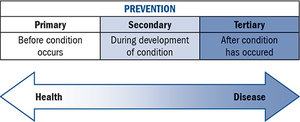Contributed by Claire Johnson, DC, MSEd, PhD; Bart Green, DC, MSEd, PhD; Scott Haldeman, DC, MD, PhD, FRCP(C)
As health practitioners, we help people with their health problems and assist them with health promotion and disease prevention.
Chiropractic care is now integrated into more and more health care settings. As we communicate with other health professionals, it is important that we correctly use terminology. Because there is confusion at times pertaining to the terms care and prevention, we offer this brief clarification on this important topic for the practicing chiropractor.
1. Primary vs. Secondary vs. Tertiary Care
"Care" is the type of health service provided by a health professional1 and is classically divided into three levels:
Primary care is care typically provided by a health care professional who is the first point of contact for a person presenting to the health care system.2 Primary care is accessed by the most number of people for the most common health concerns.
 For example, an individual may present with uncomplicated low back pain due to a sprain / strain from a lifting injury. Primary care might include spinal manipulation, therapeutic exercise, recommendations to stay active, and education about proper lifting to avoid reinjury.
For example, an individual may present with uncomplicated low back pain due to a sprain / strain from a lifting injury. Primary care might include spinal manipulation, therapeutic exercise, recommendations to stay active, and education about proper lifting to avoid reinjury.
Secondary care is care provided by a health care professional who is a specialist. Only some people will need secondary care. For example, a patient may present with neck pain and signs of severe, progressive radiculopathy. In this case, a radiology team would provide diagnostic imaging services, a radiologist would provide professional interpretation of the images, and a neurologist may join in to further consult with the patient.
Tertiary care is care provided by a team of health care professionals for patients who need advanced, coordinated care in a hospital setting.3 Tertiary care is needed by only a few people. For example, a patient may present with an aggressive spinal cord tumor. A neurosurgeon would perform the spinal surgery, nurses would provide supportive care, and therapists would immediately follow surgery with postoperative rehabilitative therapies.
2. Primary vs. Secondary vs. Tertiary Prevention
"Prevention" is an intervention strategy aimed at preventing or slowing progression of injury or a health condition4 and is typically divided into three levels:
 Primary prevention reduces health risks before a disease or condition occurs by preventing exposure or unsafe behaviors that cause disease or injury. For example, to prevent spina bifida or spinal defects from developing in the fetus, folic acid should be included in the diet of pregnant women.5
Primary prevention reduces health risks before a disease or condition occurs by preventing exposure or unsafe behaviors that cause disease or injury. For example, to prevent spina bifida or spinal defects from developing in the fetus, folic acid should be included in the diet of pregnant women.5
Secondary prevention reduces a disease or condition by catching it as early as possible, even before symptoms begin. Thus, secondary prevention slows or stops progression of the disorder. For example, to reduce the likelihood of vertebral fractures associated with osteoporosis, bone density screening can be performed in older, at-risk adults to detect low bone mineral density so dietary and activity interventions can be implemented as early as possible.6
Tertiary prevention slows the worsening or complications of an existing disease or condition and establishes the highest quality of life possible. For example, for patients with chronic and intractable pain, tertiary prevention would aim to keep the pain to its lowest severity and the patient's levels of function as high as possible, in order for the patient to have the best possible quality of life.7
3. Primary Care vs. Primary Prevention
It is easy to see how these terms can be confused; however, primary care and primary prevention have different meanings. Based upon the above definitions, we can see that primary care is about the level of health service, whereas primary prevention relates to the type of prevention strategy used to prevent diseases or disorders. Care is directed at individual patients, whereas primary, secondary and tertiary prevention can be implemented either with an individual or at a community level.
4. Levels of Prevention DCs Can Apply in Practice
Doctors of chiropractic can apply all three levels of prevention in practice. For primary prevention, we aim to prevent health conditions from ever beginning through recommendations to individual patients and by participating in our local and national community health prevention efforts. For secondary prevention, we may perform screenings to identify conditions and to educate patients with preventing these conditions or injuries from occurring.
Tertiary prevention is something that most chiropractors use with patients who have injuries or are in pain. These prevention activities may include education, rehabilitation, exercise recommendations, focusing on quality of life, and establishing realistic care goals and expectations.
References
- A Glossary of Terms for Community Health Care and Services for Older Persons. WHO, 2004.
- Muldoon LK, et al. Primary care (PC) and primary health care (PHC): what is the difference? Canadian J Public Health / Revue Canadienne de Sante'e Publique, 2006 Sep 1:409-11.
- Starfield B. Is primary care essential? Lancet, 1994 Oct 22;344(8930):1129-33.
- Simeonsson RJ. Primary, secondary, and tertiary prevention in early intervention. J Early Intervention, 1991 Apr 1;15(2):124-34.
- MRC Vitamin Study Research Group. Prevention of neural tube defects: results of the Medical Research Council Vitamin Study. Lancet, 1991 Jul 20;338(8760):131-7.
- Tang BM, et al. Use of calcium or calcium in combination with vitamin D supplementation to prevent fractures and bone loss in people aged 50 years and older: a meta-analysis. Lancet, 2007 Aug 31;370(9588):657-66.
- Waddell G, Burton AK. Occupational health guidelines for the management of low back pain at work: evidence review. Occupational Med, 2001 Mar 1;51(2):124-35.
Click here for more information about Public Health, Wellness & Prevention Contributors.





